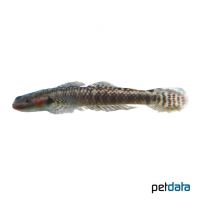Blue Neon Goby (Stiphodon atropurpureus)
| Blue Neon Goby Stiphodon atropurpureus | |
|---|---|
| Name | Blue Neon Goby |
| Name Lat. | Stiphodon atropurpureus |
| Synonym | Stiphodon formosum |
| Family | Gobies |
| Family lat. | Gobiidae |
| Order | Gobies |
| Order lat. | Gobiiformes |
| Origin | Southeast Asia |
| Habitat | Streams, rivers |
| Diet | Limnivore |
| pH | 6.5-7.5 |
| Behavior | Peaceful |
| Keeping | Pair, group |
| Care Level | Moderate |
| Reproduction | Substrate spawner |
| Breeding | None reported |
| Life Span | 2-3 years |
| Protection | No |
| Metric Units | |
| Size | 5 cm |
| Temperature | 22-28 °C |
| Hardness | 2-12 °dH |
| Aquarium | ~ 80 l |
| US Units | |
| Size | 2" |
| Temperature | 72-82 °F |
| Hardness | 36-214 ppm |
| Aquarium | ~ 20 gal |
Distribution and habitat
The distribution area of the blue neon goby stretches from southern Japan through Taiwan and the Philippines to Malaysia. They live in small rivers and streams that flow directly into the sea and like to stay in the current, often near waterfalls, between stones and roots
Maintenance
The aquarium should have partly dense planting and be structured with round river pebbles, flat stones, roots and caves. A graveable substrate of sand or a fine-grained round gravel, which can be covered with some foliage (sea almond tree, oak) as well as oxygen-rich water with a moderate to strong current is ideal
No ammonia, ammonium and nitrite should be detectable, the nitrate value should not exceed 100 mg/l. To ensure the water quality and oxygen content, a filter and heater adapted to the aquarium size is required, as well as lighting for the species-appropriate day-night rhythm of the animals.
Diet
They feed on the plant cover (growth) of stones, wood, plants, etc. and microorganisms contained therein. In addition to the algae growth in the aquarium, the food supply consists of live or frozen cyclops, artemia, daphnia, etc. or a frozen food mixture for plankton eaters as well as algae leaves. Also high-quality sinking dry food (granules, tablets) with vegetable components (e.g. spirulina) is usually well accepted after habituation, but should not be the main component of the diet.
Only as much should be fed as is eaten within a few minutes. A regular and varied diet promotes health and increases resistance.
Behaviour and compatibility
The lively Blue Neon Gobies are peaceful fish and should only be kept in pairs or better in a group of at least 5. They can be well socialized with other, not too large and peaceful fish, like Danios, Rainbowfish etc. but also shrimps (Caridina, Neocaridina). Basically, only compatible fish species with similar demands on water conditions and water temperature should be socialized.
Sex dimorphism
The sexes are difficult to distinguish. The more intensely colored males have a gray-blue hue that develops into vibrant neon colors during the spawning season.
Reproduction and breeding
There are no known reports of successful breeding in the aquarium, although egg laying does occur. The male digs a burrow under a rock where the female lays thousands of tiny eggs, which are guarded by the male. After about 48 hours the larvae hatch and their yolk sac is used up after 3-4 days. In nature, they must have reached the sea with the current during this time to find more food. After 3-4 months of pelagic development in the sea, they return to freshwater and swim back upstream the streams and small rivers.
Important
Gobies like to sit on flat or round rocks in the current. With their pelvic fins formed into a suction disc, they can stay in the current and overcome rapids and waterfalls with overhanging rocks.
Their body markings and coloration (light, dark) can vary greatly, making it difficult to distinguish between species. They can also change color intensity rapidly, e.g. during territorial disputes
The well-being of the fish should be checked regularly. Temperature should be checked daily, pH, hardness and nitrate levels at least fortnightly. Regular partial water changes are recommended, even if the contaminant level has not yet reached the upper limit. Sudden changes in water quality should be avoided. Newly introduced fish must be accustomed slowly to the water in the aquarium
Further literature can be found in your pet store.
References
Text: Werner Winter; Image: petdata
Source: BMEL (1998): Tierschutzgutachten - Haltung von Zierfischen (Süßwasser); BAENSCH & RIEHL (2004): Aquarien Atlas Bd. 2, Mergus Verlag; ENGELMANN (2005): Zootierhaltung - Tiere in menschlicher Obhut: Fische, Verlag Harri Deutsch
- Gemäß § 21 Abs. 5 Tierschutzgesetz idgF
